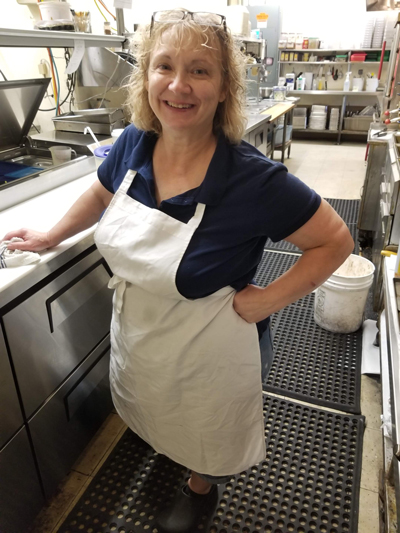Experiencing Energy Burden in Clayton County
Clean Energy Districts (CED) are socioeconomically and geographically inclusive and local. A Just Energy Transition must include everyone, especially those often left behind. CED’s are transforming the structure of the vast and powerful energy system by working at household and community levels.
Think about this: Pizza vs. Power
The many determining factors of where an Iowan will purchase and enjoy their next pizza will include the pizza cost, the kind of crust and toppings, the location of the pizza-making establishment, and maybe even the pizza maker themselves.
But the determining factor for purchasing the essential energy needed to power, heat, cool Iowa homes is the home’s address and nothing else. Therefore, Iowan’s wanting to affect their utility rates must consider relocating into a different utility company’s service area.
Public utilities are regulated by monopolies with predefined areas. This system controls the unit price of electricity and gas. While energy consumption is necessary to live in modern society, most folks have zero power over how much their power will cost. Ultimately, we have lots of liberty when it comes to buying pizza but very little liberty when it comes to buying our vital energy supply.
 And when it comes to those with the thinnest of financial resources, the injustice is the loudest. At a percentage of income, the poorest among us pay the most for their energy, meaning for many rural Iowans, utility bills are burdensome.
And when it comes to those with the thinnest of financial resources, the injustice is the loudest. At a percentage of income, the poorest among us pay the most for their energy, meaning for many rural Iowans, utility bills are burdensome.
Nonprofit clean energy districts, like the Clayton County Energy District (CCED), strengthen the county of location by leading, implementing, and accelerating the inclusive, locally-owned transition to clean energy. CED champions teach and implement the good news,
If the transition to clean energy is not inclusive and leaves many behind, our communities will become weaker, not stronger.
SPOTLIGHT: Helen Backes
Helen Backes is a 50ish single mother of four adult children who works as the full-time main cook at a popular, locally-owned restaurant in Elkader, IA. She lives in a rented home, a walkable distance from where she works. She enjoys her job and her co-workers saying, “I feel like I do a service for the community. I enjoy cooking, and I hope people come out for the good food.”
For most of her adult life, her utility bills have been a burden for her. Her current energy burden rate is 11%. Often, she struggled to pay her household utility bills on time. When her kids were young, keeping them in clothes and paying for everyone’s living expenses and school supplies on top of high energy bills was very difficult.
She recalls, “One winter, my job was eliminated, and I remember, I had to use all of my severance payment to fill our LP tank for winter.” Her then-husband was farming, and they had three kids, with one on the way. Helen says, “It was hard to keep the lights on in the old farmhouse we rented in rural Clayton County. It took a lot of gas to keep that old house heated.” There were times in her life she was behind on utility bills and has been disconnected from her utility service.
Helen understands energy efficiency and the benefits of solar energy. In the winter, she tries to keep her home heating bills lower by keeping her thermostat set low, but she admits the recent extreme summer heat, and the cost of electricity for the central air unit is more difficult to control.
Clayton County is rural with a population of 17,600. Iowans’ average energy burden rate is 3%, while the Clayton County residential average is two ticks higher at 5%. However, this doesn’t reflect the truly oppressive picture of Clayton County’s low-income earners.
According to the U.S. Department of Energy’s Low-Income Energy Affordability Data (LEAD) tool, nearly 10% of 7,600 Clayton County households live at or below the Federal Poverty Line. These households have a whopping energy burden of 26%! As incomes go up, the energy burden declines, proven by the fact 2,700 households earning more than 400% above the poverty line have an energy burden of only 3% (see figure below).

63% of Clayton County households have a high energy burden ranging from 7-26%. This dire situation is a combination of lower average household incomes and higher energy costs. Many rural residents experience a compounding problem because they are forced to rely on costly bottled gas or propane versus more affordable utility-supplied natural gas. These figures do not include money spent on transportation energy, which is naturally higher for rural residents who often commute long distances. (see figure below).

Clean energy districts work in numerous ways to reduce household energy burden. One proven program is the First Step Home Efficiency Program. These programs partner with Green Iowa AmeriCorps teams and help disadvantaged households provide unbiased, high-caliber energy assessment sessions. These sessions test combustion safety and air leakage, conduct whole-home LED upgrades and air sealing, and install water-saving devices. A final report is provided with energy savings steps like solar and geothermal energy. Over 150 Clayton County households have received the free service, resulting in $16,238 in total audited household energy savings per year.
While we focus the clean energy program toward individuals, CED’s also work on the unjust structural aspects of the energy system weakening our communities. Remember, we might choose our pizza source, but we are captives of the monopoly energy system.
Consumer-owned utilities are important assets in this process. CED’s are in action with the municipal electric utilities and rural electric cooperatives, leading programs ranging from energy efficiency, consumer-owned solar, and inclusive beneficial electrification. We think consumer-owned municipalization should be an option for communities everywhere.
While addressing the energy burden at the grassroots level and pursuing local ownership of energy systems, energy districts achieve just solutions for our communities. For example, CED’s teach our church, school, and town leaders that solar powering energy-efficient buildings reduce energy costs; this action, in turn, frees limited financial resources for their community strengthening mission. We also show local leaders how electric vehicle charging infrastructure bolsters the local tourism sector and is needed for rural drivers to transition to less costly electric vehicle transportation.
Now, as we crawl out of a worldwide pandemic, Clean Energy Districts are needed to implement inclusive community strengthening programs. When local champions aim the energy district mission towards those left behind and transform the structure of the vast and powerful energy system, our communities become stronger and accelerate the Just Transition to Clean Energy.
Article by Joleen Jansen, CCED Program Director for IowaRBOR.org


 Previous Post
Previous Post